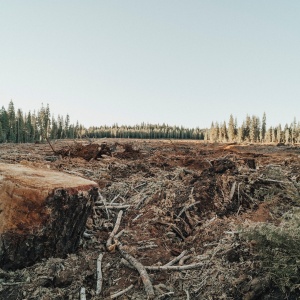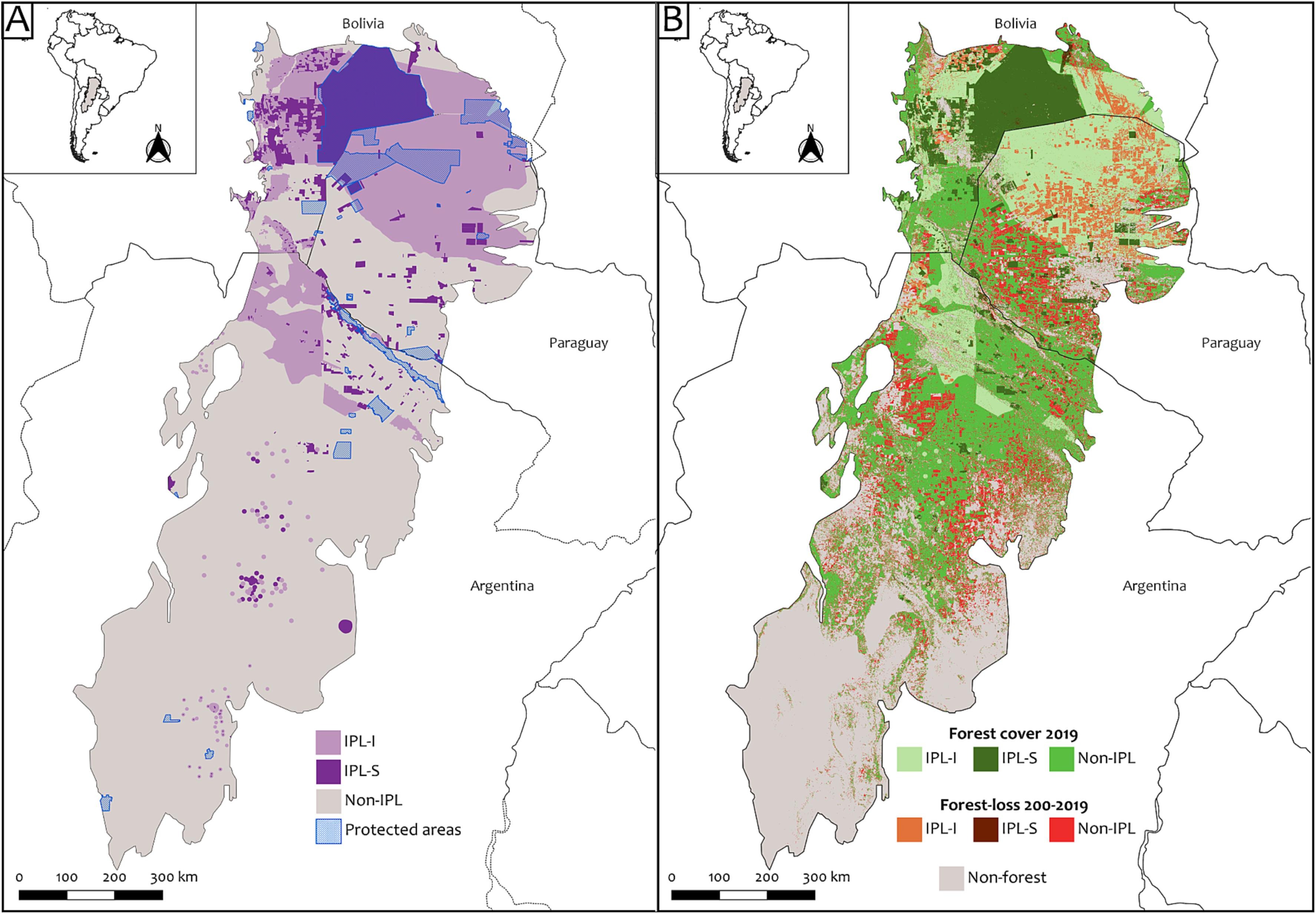
Previous studies have shown conflicting results on whether or not Indigenous Peoples Lands (IPL) can halt deforestation. This study set out to test whether these differing results reflect variations in land tenure.
Previous studies have shown conflicting results on whether or not Indigenous Peoples Lands (IPL) can halt deforestation. This study set out to test whether these differing results reflect variations in land tenure. As defined by the paper, land tenure consists of the "Institutions, policies and rules that determine who…can access, use and benefit [from] a land and its natural goods and services, and for how long".
The study first mapped IPL within the deforestation hotspot of the South American Dry Chaco (see panel A in image). The map also distinguished between two types of IPL region:
- Those with land tenure security, where the State can guarantee Indigenous peoples land-based property rights and these populations perceive their rights to be upheld.
- And those with land tenure insecurity, where Indigenous peoples either have no titles to their lands or, when they do, the State cannot guarantee their land-based property rights will be respected.
The extent of forest loss in the Dry Chaco between 2000 and 2019 was then measured (see panel B in image). Using the map of IPL regions, forest loss was compared between non-Indigenous land (non-IPL) and IPL with land tenure security (IPL-S) or insecurity (IPL-I). 44% of the remaining forests were mapped to IPL regions (either IPL-S or IPL-I). Thus, despite only covering a small proportion (30%) of the Dry Chaco in 2019, IPL regions still made a large contribution to limiting deforestation. 67% of IPL regions with remaining forests were IPL-I. This can be explained by the fact that there is significantly more IPL-I than IPL-S - 92% of IPL in the Dry Chaco was in a state of land tenure insecurity in 2019.

Image: Figure 1, Camino et al., 2023. A: Indigenous Peoples’ Lands with land tenure insecurity (IPL-I) and with land tenure security (IPL-S), land that are not Indigenous (Non-IPL), and Protected Areas in the Dry Chaco region. B: Forest cover in 2019 and forest lost between the years 2000 and 2019 in Indigenous Peoples’ Lands with land tenure insecurity (IPL-I), Indigenous Peoples’ Lands with land tenure security (IPL-S), and in lands that are not Indigenous (Non-IPL), in the Dry Chaco region.
Compared to IPL-I, IPL-S regions were found to be more effective at limiting deforestation and acting as barriers against it. IPL-S was roughly two times more effective than IPL-I at reducing forest loss in unprotected areas of Argentina; and was roughly six times more effective in unprotected areas of Paraguay.
Overall, this study highlights the importance of working with Indigenous Peoples in order to prevent deforestation. However, it also demonstrates the importance of securing the land-tenure rights of Indigenous communities. When land tenure is insecure, IPL does not necessarily limit forest loss, thus granting Indigenous Peoples land tenure rights should be a priority in forest conservation.
Paper abstract
Due to human activities, most natural ecosystems of the world have disappeared and the rest are threatened. At a global scale, 40% of the remaining forests occur in Indigenous Peoples Lands (IPL). While several studies show that IPL contribute to conserve forest-cover and halt forest-loss, other studies have found opposite results. The differing results on the role of IPL in forest conservation and loss are probably because of the effect of other variables, e.g. land tenure security. In this study, we addressed the role of IPL in forest conservation and loss, differentiating IPL with land-tenure security (IPL-S) and insecurity (IPL-I). We worked in a deforestation hotspot, the South American Dry Chaco region. First, we mapped IPL in the Dry Chaco. Then, covering the period 2000–2019, we measured forest cover and loss in IPL-S, IPL-I and in areas that are not Indigenous (non-IPL). Finally, we used a matching estimators method to statistically evaluate if IPL-S and IPL-I halt forest loss. To avoid bias, we accounted for the effect of variables such as Country (Argentina/Bolivia/Paraguay), Protected Area (yes/no), etc. We created the first map of IPL for the Dry Chaco, and found that at least 44% of the remaining forests are in IPL, and 67% of them are IPL-I. Our results also showed that IPL-S work as deforestation barriers. Inside PA, the effect of IPL-S was not always significant, probably because PA were already reducing forest loss. The effect of IPL-I on halting forest-loss was variable. We conclude that land-tenure security is key for IPL to reduce forest-loss, adding evidence on the importance of securing land-tenure rights of Indigenous communities for conservation purposes. At a regional scale, a large proportion of the remaining forests are Indigenous and conservation initiatives should be co-developed with locals, respecting their rights, needs and cosmovisions.
Reference
Camino, M., Aceves, P.A.V., Alvarez, A., Chianetta, P., de la Cruz, L.M., Alonzo, K., Vallejos, M., Zamora, L., Neme, A., Altrichter, M. and Cortez, S., 2023. Indigenous Lands with secure land-tenure can reduce forest-loss in deforestation hotspots. Global Environmental Change, 81, p.102678.
Read the full paper here. See also the TABLE Recorded Event Whose knowledge counts?







Post a new comment »